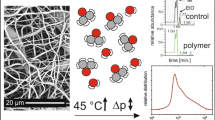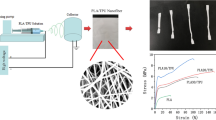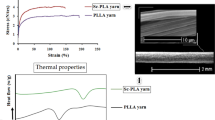Abstract—Nonwoven fibrous materials based on polylactide (PLA) and ozonide of oleic acid triglyceride (glycero-(9,10-trioxolane)-trialeate) in a range of concentrations of 1–5 wt % intended for hygienic and medical devices are obtained by electrospinning. The introduction of ozonide leads to plasticization of PLA, which manifests itself in the cleavage of the primary jet of the forming solution and appearance of ultrathin nanofibers; here, the porosity and relative elongation at break increase. The optimum weight fraction of ozonide introduced into PLA is determined to be 3 wt %.
Similar content being viewed by others
Explore related subjects
Discover the latest articles, news and stories from top researchers in related subjects.Avoid common mistakes on your manuscript.
Highly porous biopolymer materials are very important for various sectors of the national economy. Special properties are demonstrated by nonwoven biopolymer fibrous materials obtained by electrospinning [1, 2]. These materials have a high potential of implementation in medicine, hygiene, packaging, and environmental protection [3]. Particular importance and high effectiveness of such materials are observed in the field of regenerative medicine, traumatology, and orthopedics. The development of therapeutic systems, artificial implants, scaffolds, etc., based on biopolymers with high biological activity and biocompatibility is of great importance for clinical application in view of the significant increase in the fraction of aging population and the number of patients suffering from bone diseases, traumas, motor vehicle accidents, and sports-related activities. For successful application in medical practice, materials created based on biopolymers should possess a series of properties such as adequate mechanical strength, improved elasticity, absence of ability to induce hypersensitivity reactions, and good biodegradability [4].
One of the promising biopolymers widely implemented in various fields of medicine, ecology, and hygiene is polylactic acid, or polylactide (PLA). It is a multifunctional polymer. Compositions of polylactide with various additives that improve the initial properties of the material find application as bioactive fibers for drug delivery in tissue engineering. It is important to consider that the introduced modifiers should be safe for application in medical practice in addition to good compatibility with the polymer. The best option would be the presence of bactericidal properties in the additive being introduced.
It is known [5] that the plasticizing properties of vegetable and mineral oils are often used to improve the properties of polymer materials. It can be assumed that introducing an additional component such as glycero-(9,10-trioxolane)-trialeate (ozonide of oleic acid triglyceride (hereinafter, OOAT)) into initial PLA can promote expansion of the fields of its application because not only physicochemical but also morphological properties of the ready-to-use material can change in the case of such modifications. The methods of preparation of ozonated vegetable oils are well-known and described in detail [6].
Ozonide of oleic acid triglyceride (ozonide), which is characterized by nontoxicity and biocompatibility and possesses good biodegradability, is of the greatest interest among these products. This substance also possesses slight antibacterial activity owing to the presence of peroxide groups [7].
The aim of this work was to study the effect of ozonide on the structure and mechanical behavior of the fibers of PLA obtained by electrospinning. Electrospinning is comparatively cost-effective and technologically straightforward for obtaining polymer fibers with sizes from microns to nanometers.
EXPERIMENTAL
To obtain the materials, PLA of the NatureWorks Ingeo 3801X Injection Grade PLA brand (SONGHAN Plastics Technology Co., Ltd.) with a viscosity-average molecular weight of 1.9 × 105 g/mol, reagent grade chloroform (for the preparation of forming solutions), and glycero-(9,10-trioxolane)-trialeate (ozonide of oleic acid triglyceride (ozonide)) (Medozon) (Fig. 1) were used.
Nonwoven nanofibrous materials based on a 10% solution of PLA in chloroform with the addition of ozonide of oleic acid triglyceride at concentrations of 1, 3, and 5 wt % were obtained by electrospinning (Fig. 2a). To obtain ultrathin fibers by electrospinning, a unique EFV-1 single-capillary laboratory unit (Semenov Federal Research Center of Chemical Physics, Russian Academy of Sciences, Russia) (Fig. 2b) with the following process parameters was used: capillary diameter of 0.1 mm, working potential of 15 kV, distance between the electrodes of 18 cm, and electrical conductivity of the solution of 10 μS/cm.
A study of the morphology and thermal and mechanical properties of the obtained materials was performed in the work. The tensile test was carried out on a DEVOTRANS DVT GP UG universal testing machine (Turkey) in accordance with GOST (State Standard) R 53226-2008 “Nonwoven Fabrics. Methods of Strength Determination” equipped with a load sensor for 500 N which was equipped with pneumatic grips. The mechanical properties of the materials (strength, elongation at break) were measured on samples in the form of bands with a width of 10 mm at a speed of slider movement of 10 mm/min. To assess the physical and mechanical properties of the materials and to analyze the stress–strain curves, Devotrans software was used. The PLA material was cut into dumbbells using a 7.5 × 1-cm cutter. Five samples each were tested from each batch.
Optical microscopy was executed using a Micromed polar 3 ToupCam 5.1 MP microscope (Russia) in transmitted light. SEM images were obtained using a JEOL JIB-4500 electron microscope (Jeol Industries, Japan). The samples were prepared by gluing a section of the material onto an aluminum object stage using a carbon conductive tape. The samples were covered with a thin layer of platinum. All the materials were studied before and after tensile testing.
The thermal properties of the samples were studied using a PerkinElmer TGA 6 DTA analyzer (United States). The study was carried out on samples with a weight of about 10 mg. Heating was carried out in a temperature range of 35–600°C at a rate of 10°C/min in an argon flow with a flow rate of 20 mL/min.
The porosity of the nonwoven material was calculated on the basis of the values of specific surface using the Brunauer–Emmet–Teller (BET) multipoint method by direct measurements of the isotherms of adsorption/desorption of nitrogen at –196°C on an ASAP 2010 Micromeritics Instruments unit for adsorption of nitrogen (United States).
RESULTS AND DISCUSSION
At the first stage, the morphology of the nonwoven ultrafibrous materials was studied by optical microscopy (Fig. 3). Figure 3a presents the image of a fibrous material based on pure PLA. The material consists of fibers with a diameter of 6–12 μm which have a complex geometry and consist of cylindrical regions with local thickenings of 20–25 μm in the transverse and 100–150 μm in longitudinal directions.
The morphology drastically changes with the addition of ozonide. The fibers become smoother, and the thickenings almost completely disappear. The average diameter of the fibers fluctuates in a region of 8–15 μm. At the same time, ultrathin fibers appear. The uniformity of the fibers in diameter indicates stable occurrence of the process of electrostatic spinning. The stability of the process of electrospinning is affected by ozonide, simultaneously being a plasticizer and a processing additive that increases the polarity of the polymer solution. Possible plasticization of PLA with ozonide leads to a drop in the surface tension of the solution and an effect of splitting of the primary jet of the forming solution, as a result of which thinner polymer fibers can be formed.
During the detailed study of the surface of the fiber by electron microscopy (Fig. 4), a microrelief in the form of shallow longitudinal cavities alternating along the perimeter or pores was detected. Apparently, the cavities formed in the fiber in the process of desorption of the solvent.
With the introduction of 1–5 wt % ozonide, ultrathin fibers and nanofibers (0.5–3 μm) start appearing in the nonwoven materials. A substantial increase in their number is observed at a concentration of ozonide of 3 wt %. It should be noted that the morphology of nonwoven fibrous materials is characterized by higher tortuosity and entwinements. The presence of ultrathin fibers leads to the creation of a high number of engagement nodes, which creates a network structure of the material. It should also be noted that the shape of the microscopic pores is random, while the sizes fall within a range of 0.5–1 μm. The origin of the pores is induced by both evaporation of the solvent and internal processes of interaction of PLA and ozonide. Presumably, the difference of the surface morphology of the fibers with ozonide from PLA fibers is determined by the presence of an intermolecular interaction between the components in the solution at the stage of formation of the fiber. The change in the diameter of the fibers and their mutual arrangement should undoubtedly affect the porosity and, eventually, the mechanical properties of the nonwoven materials.
The average porosity of the nonwoven fibrous materials depending on the concentration of ozonide has been determined in the work. The data are presented in Fig. 5. The value of porosity has an extreme dependence with a maximum at the concentration of ozonide of 3 wt %. The increase in the porosity of the nonwoven fibrous materials apparently results from two factors, namely, the presence of nanofibers in the material which increase the free volume between the microfibers owing to their high tortuosity and the increase in the number of submicron pores on the surface with the growth in the concentration of ozonide. It can be concluded from the analysis of Figs. 3 and 4 that the morphology of the material obtained in the work includes pores (voids) between the fibers, submicroscale and microscale fibers, and submicron-range pores in the fibers themselves. All of this combined indicates the formation of a heteroporous structure.
The formed monomolecular layers of ozonide as a result of adsorption facilitate the mobility of the supramolecular structures of PLA. Low-molecular-weight ozonide acts as a structural plasticizer and facilitates the segmental mobility of PLA, thus promoting the occurrence of relaxation processes in PLA. Structural plasticization of PLA undoubtedly affects its supramolecular structure, which can significantly affect the physical and mechanical properties.
Figure 6 shows the thermograms of heating of PLA–ozonide fibrous materials. The presence of physical glass transition and phase transitions of cold crystallization and melting (enthalpies of cold crystallization and melting) is observed on the thermograms.
The glass transition of pure PLA is a sharp peak typical of semicrystalline polymers [8]. The significant decrease in the peak with the growth in the concentration of ozonide indicates a change in the structure of the amorphous regions in the plasticized polymer in the process of heating and cooling. The exothermic transition at 102°C characterizes cold crystallization of PLA without ozonide. Upon an increase in the amount of ozonide, this peak shifts to the region of low temperatures with an insignificant decrease in its intensity. An endothermic peak determined by melting of PLA is observed at about 167°C. In mixtures with ozonide, a complex exo-, endothermic peak is observed on the thermograms which is determined by the endothermic process of melting and exothermic reaction of thermal destruction of ozonide with the breaking of a C–O bond and formation of a C–OH bond. The decrease in the glass transition point and crystallization point upon heating means that ozonide facilitates the process of crystallization of PLA.
The found changes in the structure of the obtained samples as a result of the work affect the strength characteristics of the modified fibers. Figure 7 presents the dependences of strength and relative elongation at break. In the case of introducing 1 wt % ozonide into PLA, a sharp increase in the strength of the material to 6 MPa and a significant growth in elongation (above 1% ozonide) are observed owing to the presence of ozonide in the intermolecular space of PLA.
In the case of introducing 3 wt % ozonide, a sharp growth in elongation with a simultaneous decrease in the strength of the material is observed. Upon an increase in the concentration of ozonide to 5 wt %, the strength of the nonwoven fibrous materials decreases significantly. Such a behavior of the mechanical indicators directly points to an effect of plasticization of the polymer in the fibers. The decrease in elongation above 5 wt % ozonide probably occurs because, at this concentration, ozonide starts accumulating in the fiber in the form of an individual phase and, hence, starts acting as a stress concentrator in the fiber.
Figure 8 presents the stress–strain curves of the nonwoven materials depending on the composition. It is seen that the dependences have the same shape for all the nonwoven materials. The materials extend like networks. At the initial moment of loading, compaction of the material with simultaneous extension to the moment of breaking of the individual filaments forming the engagement nodes occurs, as is presented in the optical photographic images (Fig. 9). Here, it is seen that deformability grows with the increase in the concentration of ozonide, i.e., the materials become more elastic.
Figure 10 shows the electron micrographs of the nonwoven fibrous materials at the points of breaking of the sample. It should be noted that typical failure without substantial deformation of the fiber occurs in the samples with 1 wt % ozonide.
At a concentration of ozonide of 3–5 wt %, more significant extension of the fibers is observed, which is indicated by the decrease in the cross section of the monofiber at the point of failure (see Figs. 10b, 10c). It can be assumed that both elastic and plastic deformations simultaneously appear in the fibrous structure. This behavior of the fibers in the field of action of extension forces can be implemented only owing to the plasticizing action of ozonide.
CONCLUSIONS
Fundamentally new nonwoven materials based on PLA with the addition of ozonide of oleic acid triglyceride have been obtained as a result of the work. The obtained materials possess improved characteristics in comparison with the unmodified nonwoven material. The analysis of the data has shown that the additives modify the porosity of the fibers. The addition of ozonated oil leads to a decrease in the average diameter of the fibers in comparison with the initial polymer. Adding above 3 wt % ozonated oil to a solution of polylactide in chloroform leads to the formation of elastic fibers. The results of thermal analysis demonstrate a significant effect of the amount of introduced ozonide on the cold crystallization and melting of PLA. The addition of ozonide promotes amorphization of the fibers and a decrease in the degree of crystallinity, because of which the elasticity indicators of the material substantially increase. The optimum weight fraction of introduced ozonide of 3 wt % has been found. Here, it is known that ozonated oil possesses antibacterial, antifungal, and other biologically active properties; among others, it improves healing of wounds in the case of burns and other skin injuries. Because of this, the developed materials can be used in medicine for the production of dressings; suture materials; and single-use masks, suits, and sheets.
REFERENCES
Malakhov, S.N. and Chvalun, S.N., Functional nonwoven materials obtained by electrospinning from a polymer melt, Fibre Chem., 2017, vol. 49, pp. 173–182. https://doi.org/10.1007/s10692-017-9865-z
Bonartsev, A.P., Ol’khov, A.A., Khan, O.I., et al., Matrices for tissue engineering based on ultrafine fibers and microparticles of poly(hydroxybutyrate), Inorg. Mater.: Appl. Res., 2021, vol. 12, pp. 974–979. https://doi.org/10.1134/S2075113321040080
Madej-Kiełbik, L., Gzyra-Jagieła, K., Jóźwik-Pruska, J., Wiśniewskia-Wrona, M., and Dymel, M., Biodegradable nonwoven materials with antipathogenic layer, Environments, 2022, vol. 9, p. 79. https://doi.org/10.3390/environments9070079
Reddy, M.S.B., Ponnamma, D., Choudhary, R., and Sadasivuni, K.K., A comparative review of natural and synthetic biopolymer composite scaffolds, Polymers, 2021, vol. 13, p. 1105. https://doi.org/10.3390/polym13071105
Bruster, B., Adjoua, Y.-O., Dieden, R., Grysan, P., Federico, C.E., Berthé, V., and Addiego, F., Plasticization of polylactide with myrcene and limonene as bio-based plasticizers: Conventional vs. reactive extrusion, Polymers, 2019, vol. 11, p. 1363. https://doi.org/10.3390/polym11081363
Soriano, N.U., Migo, V.P., and Matsumura, M., Ozonized vegetable oil as pour point depressant for neat biodiesel, Fuel, 2006, vol. 85, no. 1, pp. 25–31. https://doi.org/10.1016/j.fuel.2005.06.00
Olkhov, A., Alexeeva, O., Konstantinova, M., Podmasterev, V., Tyubaeva, P., Borunova, A., Siracusa, V., and Iordanskii, A.L., Effect of glycero-(9,10-trioxolane)-trialeate on the physicochemical properties of non-woven polylactic acid fiber materials, Polymers, 2021, vol. 13, p. 2517. https://doi.org/10.3390/polym13152517
Gao, C., Bao, X., Yu, L., Liu, H., Simon, G.P., Chen, L., and Liu, X., Thermal properties and miscibility of semi-crystalline and amorphous PLA blends, J. Appl. Polym. Sci., 2014, vol. 131, p. 41205. https://doi.org/10.1002/app.41205
Funding
This work was financially supported by the Plekhanov Russian University of Economics.
Author information
Authors and Affiliations
Corresponding author
Ethics declarations
The authors of this work declare that they have no conflicts of interest.
Additional information
Translated by E. Boltukhina
Publisher’s Note.
Pleiades Publishing remains neutral with regard to jurisdictional claims in published maps and institutional affiliations.
Rights and permissions
About this article
Cite this article
Olkhov, A.A., Alekseeva, O.V., Konstantinova, M.L. et al. Effect of Glycero-(9,10-trioxolane)-trialeate Ozonide on Structure and Mechanical Properties of Ultrathin Polylactide Fibers Produced by Electrospinning. Inorg. Mater. Appl. Res. 15, 1023–1030 (2024). https://doi.org/10.1134/S2075113324700552
Received:
Revised:
Accepted:
Published:
Issue Date:
DOI: https://doi.org/10.1134/S2075113324700552














